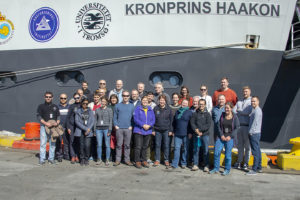Now, our expedition is over and we are docked onto the pier in Cape Town, where we will finally step onto solid ground again. Before saying goodbye here on the blog, I would like to tell you a bit about the ship that we have been working and living on for the last 7 weeks during our Antarctic adventure:
the brand new Norwegian ice breaker RV Kronprins Haakon.
Norway has a long history in polar research. The research institutes always make sure that they have the infrastructure to conduct fieldwork in rough conditions and heavy sea ice. Following the examples of “Fram” and “Maud” on which Fridtjof Nansen and Roald Amundsen wrote history, “Kronprins Haakon” has now started to cut through the ice for the new generation of polar explorers. During the last decades, “Lance” was used for polar research although she was originally built for fishing and sealing. However, now she is an old lady from 1978, who has already sailed to the moon and back in distance (860 000km) and has finally retired in 2017 from the duty for the Norwegian Polar Institute. “Kronprins Haakon” was built in Genova, Italy, and is now jointly owned by the University of Tromsø (50 %), Norwegian Polar Institute (30 %) and Norwegian Institute of Marine Research (20 %). On November 17, 2018, the ice breaker was baptized by the Princess Ingrid Aleksandra in a very symbolic way: with a sea ice core to symbolize the use of the ship in polar regions.
The 100 m long ship has room for 55 people including the crew, but most of the space is used for the 14 laboratories, a helipad, hangars for two helicopters and a moonpool to lower instruments into the ocean even with thick sea ice cover. In addition, it has a remotely controlled submarine that goes down to 6000 m depth, an eccosounder to measure the ocean floor and organisms in detail, and many other instruments. Here you can see a youtube video about the ship: https://www.youtube.com/watch?v=ok6KWKznzXo&feature=youtu.be

